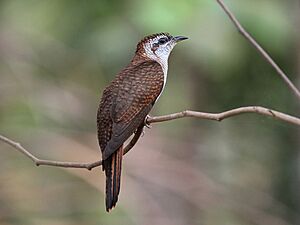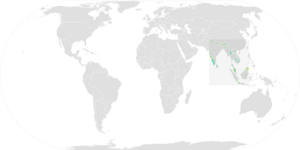Banded bay cuckoo facts for kids
Quick facts for kids Banded bay cuckoo |
|
|---|---|
 |
|
| C. s. sonneratii from Kerala, India |
|
| Conservation status | |
| Scientific classification | |
| Genus: |
Cacomantis
|
| Species: |
sonneratii
|
 |
|
| Global range Year-Round Range Summer Range Winter Range | |
| Synonyms | |
|
Penthoceryx sonneratii |
|
The banded bay cuckoo (Cacomantis sonneratii) is a small bird found in India, Southeast Asia, and nearby regions. These cuckoos usually live in areas with lots of trees, especially in lower hills.
Male cuckoos sing from open branches during their breeding season. This season can happen at different times depending on where they live. These birds are easy to spot because of their unique calls and colorful feathers. They have a white stripe above their eyes, reddish-brown upper parts with dark bands, and a whitish belly with thin stripes.
What Does the Banded Bay Cuckoo Look Like?
Adult banded bay cuckoos have bright reddish-brown (or "bay") feathers on their head and back. These feathers also have wide, dark brown stripes. Their beak is long and curves a little. You can easily see a whitish stripe, like an eyebrow, above their dark eyes.
Their wings are darker, and their tail gets narrower towards the end. The tail has a dark brown center, a black band near the tip, and white tips on the feathers. Both male and female cuckoos look alike. Their eyes are yellow, and their beak is black, though the bottom part is greenish-grey. Their legs are grey. Young cuckoos look similar but have a lighter lower beak and white edges on their upper body feathers.
This cuckoo is about 22 centimeters (about 8.5 inches) long. This makes it about the same size as some other cuckoos found in the same areas.
Where Does the Banded Bay Cuckoo Live?
The banded bay cuckoo was first described by a scientist named John Latham. The name sonneratii honors a French explorer, Pierre Sonnerat.
Scientists recognize a few different types, or subspecies, of the banded bay cuckoo:
- The most common type is found in India, Nepal, Thailand, and the Malay Peninsula.
- Other types live in places like Java, Bali, Sumatra, and Sri Lanka.
How Do Banded Bay Cuckoos Live?
Like many other cuckoos, banded bay cuckoos are "brood parasites." This means they lay their eggs in the nests of other birds. The host birds then raise the cuckoo chicks as their own. Some birds known to host cuckoo eggs include the common iora, red-whiskered bulbul, and various small babblers. The cuckoo's eggs often look similar to the host bird's eggs.
Cuckoo chicks are known to push the host's own chicks out of the nest. This ensures they get all the food and care from the host parents.
Some groups of these cuckoos move to different places during the year. In India, they are often seen during the monsoon season.
These birds prefer to live in thick forests, especially in hilly regions. They mainly eat insects. They catch insects by picking them off leaves and branches (called gleaning) or by flying out to snatch them in the air (called aerial sallying).
The time when they lay eggs changes a lot depending on the area. For example, near Mumbai, they lay eggs from February to August. In Sri Lanka, young cuckoos have been seen in June and October.
The call of the banded bay cuckoo is very special. It's a high-pitched, four-note whistle. People often describe it as sounding like "wee-ti wee-tee" or "smoke-yer-pepper." Each note drops in pitch, and the whole call lasts about one second.



